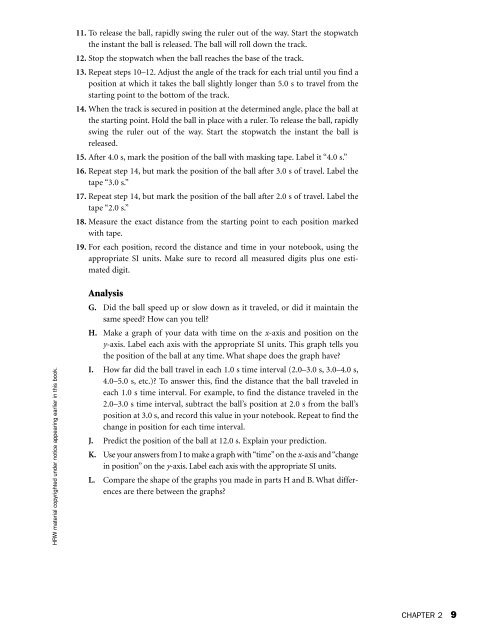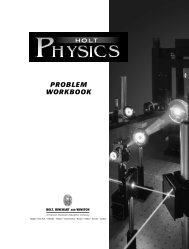LABORATORY EXPERIMENTS
LABORATORY EXPERIMENTS - Langlo Press - langlopress.net
LABORATORY EXPERIMENTS - Langlo Press - langlopress.net
- No tags were found...
You also want an ePaper? Increase the reach of your titles
YUMPU automatically turns print PDFs into web optimized ePapers that Google loves.
11. To release the ball, rapidly swing the ruler out of the way. Start the stopwatch<br />
the instant the ball is released. The ball will roll down the track.<br />
12. Stop the stopwatch when the ball reaches the base of the track.<br />
13. Repeat steps 10–12. Adjust the angle of the track for each trial until you find a<br />
position at which it takes the ball slightly longer than 5.0 s to travel from the<br />
starting point to the bottom of the track.<br />
14. When the track is secured in position at the determined angle, place the ball at<br />
the starting point. Hold the ball in place with a ruler. To release the ball, rapidly<br />
swing the ruler out of the way. Start the stopwatch the instant the ball is<br />
released.<br />
15. After 4.0 s, mark the position of the ball with masking tape. Label it “4.0 s.”<br />
16. Repeat step 14, but mark the position of the ball after 3.0 s of travel. Label the<br />
tape “3.0 s.”<br />
17. Repeat step 14, but mark the position of the ball after 2.0 s of travel. Label the<br />
tape “2.0 s.”<br />
18. Measure the exact distance from the starting point to each position marked<br />
with tape.<br />
19. For each position, record the distance and time in your notebook, using the<br />
appropriate SI units. Make sure to record all measured digits plus one estimated<br />
digit.<br />
HRW material copyrighted under notice appearing earlier in this book.<br />
Analysis<br />
G. Did the ball speed up or slow down as it traveled, or did it maintain the<br />
same speed? How can you tell?<br />
H. Make a graph of your data with time on the x-axis and position on the<br />
y-axis. Label each axis with the appropriate SI units. This graph tells you<br />
the position of the ball at any time. What shape does the graph have?<br />
I. How far did the ball travel in each 1.0 s time interval (2.0–3.0 s, 3.0–4.0 s,<br />
4.0–5.0 s, etc.)? To answer this, find the distance that the ball traveled in<br />
each 1.0 s time interval. For example, to find the distance traveled in the<br />
2.0–3.0 s time interval, subtract the ball’s position at 2.0 s from the ball’s<br />
position at 3.0 s, and record this value in your notebook. Repeat to find the<br />
change in position for each time interval.<br />
J. Predict the position of the ball at 12.0 s. Explain your prediction.<br />
K. Use your answers from I to make a graph with “time”on the x-axis and “change<br />
in position” on the y-axis. Label each axis with the appropriate SI units.<br />
L. Compare the shape of the graphs you made in parts H and B. What differences<br />
are there between the graphs?<br />
CHAPTER 2 9





